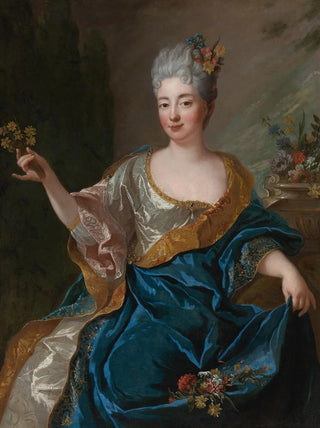Art print | Portrait of a lady - Jean-François de Troy


View from behind

Frame (optional)
Portrait of a Lady - Jean-François de Troy – Captivating Introduction
The "Portrait of a Lady" by Jean-François de Troy is a work that embodies the elegance and subtlety of 18th-century French art. This painting, both intimate and universal, immerses us in the refined world of the court and Parisian salons. The artist manages to capture not only the physical appearance of his model but also the very essence of her personality, creating an emotional connection between the viewer and the depicted figure. Through this artwork, de Troy invites us to explore the nuances of feminine beauty while offering a glimpse into the fashion and customs of his era.
Style and uniqueness of the work
Jean-François de Troy's style is distinguished by its finesse and attention to detail. In "Portrait of a Lady," each brushstroke appears carefully considered, contributing to a harmonious composition where light plays a leading role. The color palette, soft and luminous, evokes the delicacy of skin and the richness of fabrics, while the lady's gaze, both mysterious and engaging, inevitably draws the eye. De Troy employs a painting technique that combines realism and idealization, creating a portrait that transcends mere physical likeness to become a true celebration of femininity. This painting also stands out for its narrative frame, where every element, from clothing to accessories, tells a story—one of a time when appearance was synonymous with social status and refinement.
The artist and his influence
Jean-François de Troy, born in 1679, was a French painter whose work significantly contributed to shaping the artistic landscape of his time. A student of Nicolas de Largillière, he quickly distinguished himself by his talent and ability to capture the psychology of his models. His career, marked by travels to Italy, allowed him to incorporate classical influences into his work while maintaining a sensitivity unique to French art. De Troy was also known for his talents as a decorator and his participation in prestigious projects, which attests to his importance in the 18th-century artistic milieu. His influence is evident among many contemporary artists who admire his technical mastery and his

Matte finish

View from behind

Frame (optional)
Portrait of a Lady - Jean-François de Troy – Captivating Introduction
The "Portrait of a Lady" by Jean-François de Troy is a work that embodies the elegance and subtlety of 18th-century French art. This painting, both intimate and universal, immerses us in the refined world of the court and Parisian salons. The artist manages to capture not only the physical appearance of his model but also the very essence of her personality, creating an emotional connection between the viewer and the depicted figure. Through this artwork, de Troy invites us to explore the nuances of feminine beauty while offering a glimpse into the fashion and customs of his era.
Style and uniqueness of the work
Jean-François de Troy's style is distinguished by its finesse and attention to detail. In "Portrait of a Lady," each brushstroke appears carefully considered, contributing to a harmonious composition where light plays a leading role. The color palette, soft and luminous, evokes the delicacy of skin and the richness of fabrics, while the lady's gaze, both mysterious and engaging, inevitably draws the eye. De Troy employs a painting technique that combines realism and idealization, creating a portrait that transcends mere physical likeness to become a true celebration of femininity. This painting also stands out for its narrative frame, where every element, from clothing to accessories, tells a story—one of a time when appearance was synonymous with social status and refinement.
The artist and his influence
Jean-François de Troy, born in 1679, was a French painter whose work significantly contributed to shaping the artistic landscape of his time. A student of Nicolas de Largillière, he quickly distinguished himself by his talent and ability to capture the psychology of his models. His career, marked by travels to Italy, allowed him to incorporate classical influences into his work while maintaining a sensitivity unique to French art. De Troy was also known for his talents as a decorator and his participation in prestigious projects, which attests to his importance in the 18th-century artistic milieu. His influence is evident among many contemporary artists who admire his technical mastery and his






